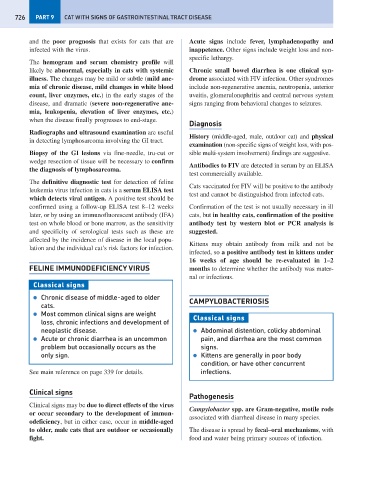Page 734 - Problem-Based Feline Medicine
P. 734
726 PART 9 CAT WITH SIGNS OF GASTROINTESTINAL TRACT DISEASE
and the poor prognosis that exists for cats that are Acute signs include fever, lymphadenopathy and
infected with the virus. inappetence. Other signs include weight loss and non-
specific lethargy.
The hemogram and serum chemistry profile will
likely be abnormal, especially in cats with systemic Chronic small bowel diarrhea is one clinical syn-
illness. The changes may be mild or subtle (mild ane- drome associated with FIV infection. Other syndromes
mia of chronic disease, mild changes in white blood include non-regenerative anemia, neutropenia, anterior
count, liver enzymes, etc.) in the early stages of the uveitis, glomerulonephritis and central nervous system
disease, and dramatic (severe non-regenerative ane- signs ranging from behavioral changes to seizures.
mia, leukopenia, elevation of liver enzymes, etc.)
when the disease finally progresses to end-stage.
Diagnosis
Radiographs and ultrasound examination are useful
History (middle-aged, male, outdoor cat) and physical
in detecting lymphosarcoma involving the GI tract.
examination (non-specific signs of weight loss, with pos-
Biopsy of the GI lesions via fine-needle, tru-cut or sible multi-system involvement) findings are suggestive.
wedge resection of tissue will be necessary to confirm
Antibodies to FIV are detected in serum by an ELISA
the diagnosis of lymphosarcoma.
test commercially available.
The definitive diagnostic test for detection of feline
Cats vaccinated for FIV will be positive to the antibody
leukemia virus infection in cats is a serum ELISA test
test and cannot be distinguished from infected cats.
which detects viral antigen. A positive test should be
confirmed using a follow-up ELISA test 8–12 weeks Confirmation of the test is not usually necessary in ill
later, or by using an immunofluorescent antibody (IFA) cats, but in healthy cats, confirmation of the positive
test on whole blood or bone marrow, as the sensitivity antibody test by western blot or PCR analysis is
and specificity of serological tests such as these are suggested.
affected by the incidence of disease in the local popu-
Kittens may obtain antibody from milk and not be
lation and the individual cat’s risk factors for infection.
infected, so a positive antibody test in kittens under
16 weeks of age should be re-evaluated in 1–2
FELINE IMMUNODEFICIENCY VIRUS months to determine whether the antibody was mater-
nal or infectious.
Classical signs
● Chronic disease of middle-aged to older CAMPYLOBACTERIOSIS
cats.
● Most common clinical signs are weight
Classical signs
loss, chronic infections and development of
neoplastic disease. ● Abdominal distention, colicky abdominal
● Acute or chronic diarrhea is an uncommon pain, and diarrhea are the most common
problem but occasionally occurs as the signs.
only sign. ● Kittens are generally in poor body
condition, or have other concurrent
See main reference on page 339 for details. infections.
Clinical signs
Pathogenesis
Clinical signs may be due to direct effects of the virus
Campylobacter spp. are Gram-negative, motile rods
or occur secondary to the development of immun-
associated with diarrheal disease in many species.
odeficiency, but in either case, occur in middle-aged
to older, male cats that are outdoor or occasionally The disease is spread by fecal–oral mechanisms, with
fight. food and water being primary sources of infection.

